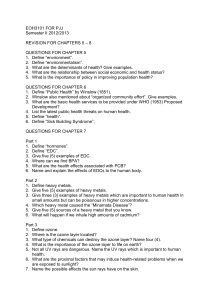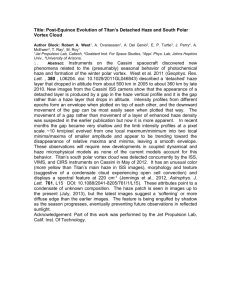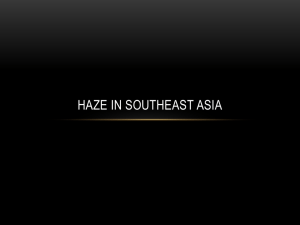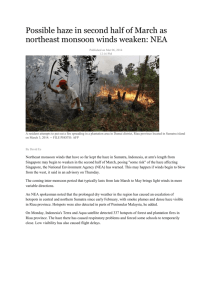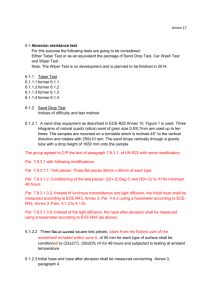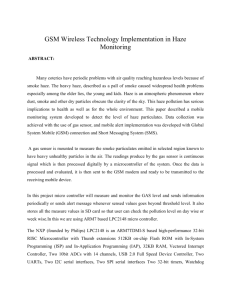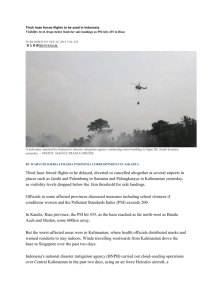Natural Haze Levels II: Application of the New IMPROVE Algorithm
advertisement
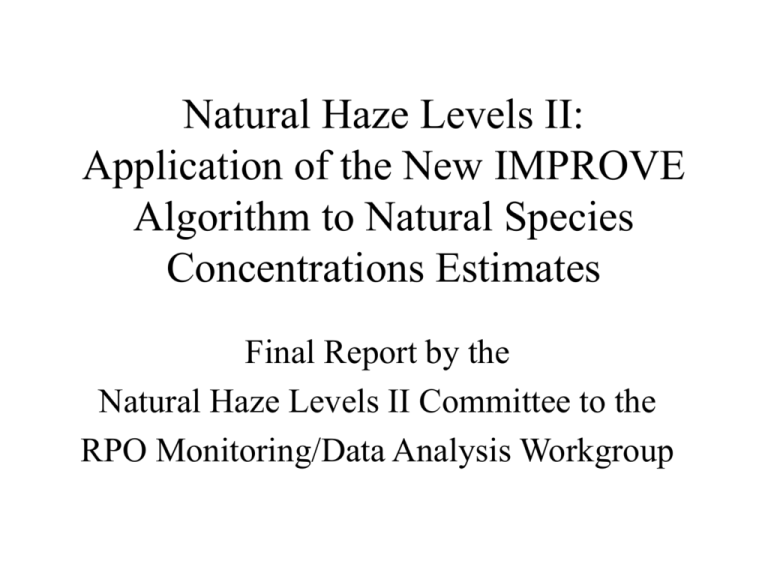
Natural Haze Levels II: Application of the New IMPROVE Algorithm to Natural Species Concentrations Estimates Final Report by the Natural Haze Levels II Committee to the RPO Monitoring/Data Analysis Workgroup Note: This presentation contains substantial additional information in the notes section of PowerPoint that can be seen in the bottom panel of the “Normal” view mode, and can be printed by selecting “Notes Pages” from the “Print what” selection of the “Print” menu (go to “Files” on the top tool bar and select “Print”). You can also use “Preview” for the “Notes Pages” to more easily read the notes on your computer monitor. These notes were prepared 1. to aid those hearing the presentation by relieving them of the burden of taking as many notes; 2. to allow those who haven’t heard the presentation to understand it by providing the additional information that is spoken during presentations; and 3. to provide a more complete documentation of the natural haze levels II approach for anyone who may want to understand it For additional information contact Marc Pitchford at Marc.Pitchford@NOAA.gov Overall Goal • Estimate 20% best and 20% worst natural haze levels for visibility-protected class I areas using the new IMPROVE algorithm for estimating light extinction from aerosol species concentrations. – Needed for Regional Haze Rule (RHR) rate of progress glide slopes where the new IMPROVE algorithm is used to characterize current haze levels – Should minimize the technical problems identified in the RHR default natural haze levels that were developed using the original IMPROVE algorithm Default Natural Haze Levels Approach • Typical haze level estimates for East and West – Typical light extinction by applying the original IMPROVE algorithm to Trijonis natural species concentration estimates for East and West – Convert to haze index (deciview units) • 20% best and 20% worst haze estimate for East and West – Best = typical – 1.28(standard deviation) – Worst = typical + 1.28(standard deviation) – Standard deviation is 3dv for the East and 2dv for the West (corresponds to the 10th and 90th percentile) Criticism of the Default Approach • Limitations of the original IMPROVE algorithm – Biased light extinction estimates at the extremes – Uses an outdated organic compound mass to carbon mass ratio – No sea salt (important at a few sites) – Rayleigh scattering of 10Mm-1 used for all site • Flawed assumptions used to estimate 20% best and worst conditions – Haze index for natural conditions are not likely to be normally distributed due to inclusion of Rayleigh scattering – 10th and 90th percentiles don’t correspond to the best and worst conditions if the distribution were normal Natural Haze Levels II Approach • Adjust each of the measured major species concentrations to the Trijonis natural concentration estimates – Multiply each species concentration at a site by the sitespecific ratio of the (Trijonis natural estimate) divided by the (annual mean concentration) for the species for the 5 year baseline period – If the annual mean concentration for a species is smaller than the Trijonis natural estimate, make no adjustment – Current sea salt levels are taken to be natural levels • Apply the new IMPROVE algorithm to the Trijonisadjusted species concentrations at each site to produce a distribution of natural light extinction values • Convert to deciview and calculate the mean of the 20% best and 20% worst haze levels Trijonis-Adjusted Specie Frequency Distributions Current 2000-2004 Natural Estimate Hanging bars Solid - current mean Dashed - natural estimate mean • Sipsey Alabama • Each aerosol species mass concentration frequency distribution scaled to estimated natural mass concentrations • If current species mean is less than natural estimate, the that species is not scaled • Geometric shape of species distributions is unchanged Current and Natural Haze Frequency Distributions • Sipsey Alabama • Natural scenario joint distribution shape is derived from scaling current aerosol species mass concentrations to natural condition estimates • Allows estimation of best and worst 20% dv or aerosol species extinction Natural Haze Levels II Default Natural Haze Levels Natural Haze Levels II, 10-Year Rate of Progress Glide Path Default Natural Haze Levels, 10-Year Rate of Progress Glide Path Status and Next Steps • This presentation is the final report of the Natural Haze Levels II Committee of the RPO Monitoring/Data Analysis Workgroup • Review comments received by August 25, 2006 will be considered in preparation of the RPO Monitoring/Data Analysis Workgroup approved approach • Workgroup approved approach is forwarded to the RPOs for their consideration by August 31, 2006 • This presentation, including the natural haze estimates and any modifications will be made available on VIEWS Appendix • Tables of Natural Haze Level II Estimates for all IMPROVE Sites by RPO and State Complete Years Worst Haze Natural II (dv) Worst Haze Baseline (dv) 10-year Glide Slope (dv) CENRAP Site Name State CACR1 Caney Creek Arkansas 3 11.7 26.4 2.4 Caney Creek UPBU1 Upper Buffalo Wilderness Arkansas 5 11.7 26.3 2.4 Upper Buffalo BRET1 Breton* Louisiana 4 12.3 0.0 0.0 Breton BOWA1 Boundary Waters Canoe Area Minnesota 2 11.6 20.0 1.4 Boundary Waters Canoe Area VOYA2 Voyageurs NP #2 Minnesota 5 12.2 19.3 1.2 Voyageurs HEGL1 Hercules-Glades Missouri 3 11.4 26.7 2.6 Hercules-Glade MING1 Mingo Missouri 1 12.5 29.5 2.8 Mingo WIMO1 Wichita Mountains Oklahoma 3 7.6 23.8 2.7 Wichita Mountains BIBE1 Big Bend NP Texas 4 7.2 17.3 1.7 Big Bend GUMO1 Guadalupe Mountains NP Texas 5 6.8 17.2 1.7 Guadalupe Mountains; Carlsbad Caverns MANE-VU & Midwest RPO Worst Haze Natural II (dv) Worst Haze Baseline (dv) 10-year Glide Slope (dv) Class I Area(s) Site Name State Complete Years ACAD1 Acadia NP Maine 5 12.5 22.9 1.7 Acadia MOOS1 Moosehorn NWR Maine 5 12.1 21.7 1.6 Moosehorn; Roosevelt Campobello GRGU1 Great Gulf Wilderness New Hampshire 4 12.1 22.8 1.8 Great Gulf; Presidential Range-Dry River BRIG1 Brigantine NWR New Jersey 5 12.3 29.0 2.8 Brigantine LYBR1 Lye Brook Wilderness Vermont 5 11.9 24.4 2.1 Lye Brook ISLE1 Isle Royale NP Michigan 5 12.5 20.7 1.4 Isle Royale SENE1 Seney Michigan 5 12.8 24.2 1.9 Seney Class I Area(s) VISTAS + VI Complet e Years Worst Haze Natural II (dv) Worst Haze Baseline (dv) 10-year Glide Slope (dv) Site Name State Class I Area(s) SIPS1 Sipsy Wilderness Alabama 4 11.1 29.0 3.0 Sipsey CHAS1 Chassahowitzka NWR Florida 3 11.3 26.1 2.5 Chassahowitzka EVER1 Everglades NP Florida 4 12.3 22.3 1.7 Everglades SAMA1 St. Marks Florida 2 11.6 26.0 2.4 Saint Marks COHU1 Cohutta Georgia 2 11.2 30.3 3.2 Cohutta OKEF1 Okefenokee NWR Georgia 5 11.5 27.1 2.6 Okefenokee; Wolf Island MACA1 Mammoth Cave NP Kentucky 5 11.2 31.4 3.4 Mammoth Cave LIGO1 Linville Gorge North Carolina 4 11.3 28.8 2.9 Linville Gorge SHRO1 Shining Rock Wilderness North Carolina 2 11.6 27.9 2.7 Shining Rock SWAN1 Swanquarter North Carolina 2 12.0 25.5 2.2 Swanquarter ROMA1 Cape Romain NWR South Carolina 5 12.2 26.5 2.4 Cape Romain GRSM1 Great Smoky Mountains NP Tennessee 5 11.3 30.3 3.2 Great Smoky Mountains; Joyce Kilmer-Slickrock JARI1 James River Face Wilderness Virginia 4 11.2 29.1 3.0 James River Face SHEN1 Shenandoah NP Virginia 5 11.4 29.3 3.0 Shenandoah DOSO1 Dolly Sods Wilderness West Virginia 5 10.4 29.0 3.1 Dolly Sods; Otter Creek VIIS1 Virgin Islands NP Virgin Islands 4 10.8 17.0 1.0 Virgin Islands WRAP Worst Haze Natural II (dv) Worst Haze Baseline (dv) 10-year Glide Slope (dv) Site Name State Complete Years DENA1 Denali NP Alaska 5 7.4 9.9 0.4 Denali SIME1 Simeonof Alaska 3 15.7 18.6 0.5 Simeonof TUXE1 Tuxedni Alaska 3 11.5 14.1 0.4 Tuxedni BALD1 Mount Baldy Arizona 2 6.6 11.5 0.8 Mount Baldy CHIR1 Chiricahua NM Arizona 5 7.3 13.4 1.0 Chiricahua NM; Chiricahua W; Galiuro GRCA2 Hance Camp at Grand Canyon NP Arizona 4 7.2 11.7 0.7 Grand Canyon IKBA1 Ike's Backbone Arizona 4 6.7 13.3 1.1 Mazatzal; Pine Mountain PEFO1 Petrified Forest NP Arizona 5 6.6 13.2 1.1 Petrified Forest SAGU1 Saguaro NM Arizona 3 6.5 14.8 1.4 Saguaro SIAN1 Sierra Ancha Arizona 4 6.7 13.7 1.2 Sierra Ancha SYCA1 Sycamore Canyon Arizona 4 6.8 15.3 1.4 Sycamore Canyon TONT1 Tonto NM Arizona 3 6.7 13.9 1.2 Superstition Class I Area(s) Complete Years Worst Haze Natural II (dv) Worst Haze Baseline (dv) 10-year Glide Slope (dv) WRAP Site Name State Class I Area(s) AGTI1 Agua Tibia California 4 7.7 23.5 2.6 Agua Tibia BLIS1 Bliss SP (TRPA) California 4 6.2 12.6 1.1 Desolation; Mokelumne DOME1 Dome Lands Wilderness California 4 7.5 19.4 2.0 Dome Land HOOV1 Hoover California 3 8.0 12.9 0.8 Hoover JOSH1 Joshua Tree NP California 4 7.3 19.6 2.1 Joshua Tree KAIS1 Kaiser California 2 7.3 14.8 1.2 Ansel Adams; Kaiser; John Muir LABE1 Lava Beds NM California 4 7.9 15.1 1.2 Lava Beds; South Warner LAVO1 Lassen Volcanic NP California 5 7.4 14.1 1.1 Lassen Volcanic; Caribou; Thousand Lakes; Caribou; Thousand Lakes PINN1 Pinnacles NM California 4 8.1 18.5 1.7 Pinnacles; Ventana PORE1 Point Reyes National Seashore California 3 15.9 22.8 1.2 Point Reyes RAFA1 San Rafael California 2 7.8 18.9 1.8 San Rafael REDW1 Redwood NP California 5 14.0 18.5 0.7 Redwood SAGA1 San Gabriel California 3 7.1 19.9 2.1 San Gabriel; Cucamonga SAGO1 San Gorgonio Wilderness California 4 7.4 22.2 2.5 San Gorgonio; San Jacinto SEQU1 Sequoia NP California 3 7.6 24.6 2.8 Sequoia; Kings Canyon TRIN1 Trinity California 3 8.3 16.3 1.3 Marble Mountain; Yolla Bolly-Middle Eel YOSE1 Yosemite NP California 5 7.7 17.6 1.7 Yosemite; Emigrant WRAP Complete Years Worst Haze Natural II (dv) Worst Haze Baseline (dv) 10-year Glide Slope (dv) Site Name State Class I Area(s) GRSA1 Great Sand Dunes NM Colorado 5 6.7 12.8 1.0 Great Sand Dunes MEVE1 Mesa Verde NP Colorado 5 6.9 13.0 1.0 Mesa Verde MOZI1 Mount Zirkel Wilderness Colorado 4 6.6 10.5 0.7 Mount Zirkel; Rawah ROMO1 Rocky Mountain NP Colorado 5 7.3 13.8 1.1 Rocky Mountain WEMI1 Weminuche Wilderness Colorado 4 6.3 10.3 0.7 La Garita; Black Canyon of the Gunnison; Weminuche WHRI1 White River NF Colorado 4 6.7 9.6 0.5 Flat Tops; Maroon Bells-Snowmass; West Elk; Eagles Nest HALE1 Haleakala NP Hawaii 4 7.5 13.3 1.0 Haleakala HAVO1 Hawaii Volcanoes NP Hawaii 4 7.2 18.9 1.9 Hawaii Volcanoes CRMO1 Craters of the Moon NM Idaho 4 7.6 14.0 1.1 Craters of the Moon SAWT1 Sawtooth NF Idaho 4 6.5 13.8 1.2 Sawtooth CABI1 Cabinet Mountains Montana 4 7.6 14.1 1.1 Cabinet Mountains GAMO1 Gates of the Mountains Montana 4 6.5 11.3 0.8 Gates of the Mountains GLAC1 Glacier NP Montana 3 9.1 20.5 1.9 Glacier MELA1 Medicine Lake Montana 5 8.0 17.7 1.6 Medicine Lake MONT1 Monture Montana 4 7.8 14.5 1.1 Bob Marshall; Mission Mountains; Scapegoat SULA1 Sula Peak Montana 4 7.5 13.4 1.0 Selway-Bitterroot; Anaconda-Pintler ULBE1 UL Bend Montana 4 8.2 15.1 1.1 UL Bend Complete Years Worst Haze Natural II (dv) Worst Haze Baseline (dv) 10-year Glide Slope (dv) WRAP Site Name State Class I Area(s) JARB1 Jarbidge Wilderness Nevada 4 8.0 12.1 0.7 Jarbidge BAND1 Bandelier NM New Mexico 5 6.3 12.2 1.0 Bandelier BOAP1 Bosque del Apache New Mexico 3 6.8 13.8 1.2 Bosque del Apache GICL1 Gila Wilderness New Mexico 4 6.8 13.1 1.1 Gila SACR1 Salt Creek New Mexico 4 6.9 18.0 1.9 Salt Creek SAPE1 San Pedro Parks New Mexico 4 6.2 10.2 0.7 San Pedro Parks WHIT1 White Mountain New Mexico 3 6.9 13.7 1.1 White Mountain WHPE1 Wheeler Peak New Mexico 3 6.6 10.4 0.6 Wheeler Peak; Pecos LOST1 Lostwood North Dakota 5 8.1 19.6 1.9 Lostwood THRO1 Theodore Roosevelt North Dakota 4 7.9 17.7 1.6 Theodore Roosevelt CRLA1 Crater Lake NP Oregon 3 8.0 13.7 1.0 Gearhart Mountain; Crater Lake; Diamond Peak; Mountain Lakes HECA1 Hells Canyon Oregon 3 8.4 18.6 1.7 Hells Canyon KALM1 Kalmiopsis Oregon 4 9.5 15.5 1.0 Kalmiopsis MOHO1 Mount Hood Oregon 4 8.5 14.9 1.1 Mount Hood STAR1 Starkey Oregon 4 9.0 18.6 1.6 Eagle Cap; Strawberry Mountain THSI1 Three Sisters Wilderness Oregon 5 8.9 15.3 1.1 Three Sisters; Mount Jefferson; Mount Washington WRAP Complete Years Worst Haze Natural II (dv) Worst Haze Baseline (dv) 10-year Glide Slope (dv) Site Name State Class I Area(s) BADL1 Badlands NP South Dakota 5 8.1 17.1 1.5 Badlands WICA1 Wind Cave South Dakota 5 7.8 15.8 1.3 Wind Cave BRCA1 Bryce Canyon NP Utah 5 7.0 11.6 0.8 Bryce Canyon CANY1 Canyonlands NP Utah 5 6.5 11.2 0.8 Canyonlands; Arches CAPI1 Capitol Reef NP Utah 2 5.7 10.0 0.7 Capitol Reef ZION1 Zion Utah 3 7.1 13.2 1.0 Zion MORA1 Mount Rainier NP Washington 4 8.6 18.2 1.6 Mount Rainier NOCA1 North Cascades Washington 2 8.1 14.0 1.0 North Cascades; Glacier Peak OLYM1 Olympic Washington 3 8.5 16.7 1.4 Olympic PASA1 Pasayten Washington 4 8.4 15.2 1.1 Pasayten SNPA1 Snoqualmie Pass Washington 4 8.5 17.8 1.6 Alpine Lakes WHPA1 White Pass Washington 4 8.5 12.8 0.7 Mount Adams; Goat Rocks BRID1 Bridger Wilderness Wyoming 5 6.7 11.1 0.7 Bridger; Fitzpatrick NOAB1 North Absaroka Wyoming 3 6.9 11.5 0.8 North Absaroka; Washakie YELL2 Yellowstone NP 2 Wyoming 5 6.6 11.8 0.9 Yellowstone; Red Rock Lakes; Grand Teton; Teton
